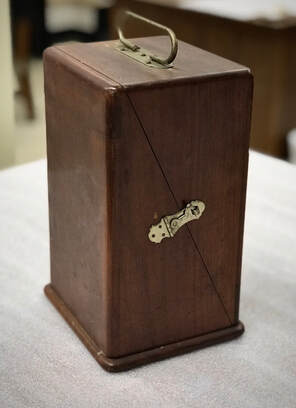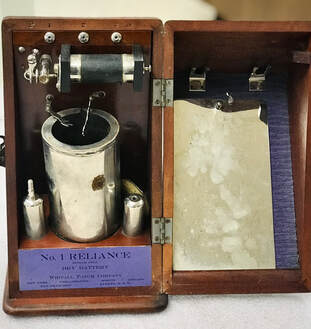Foreword by Matthew Titchiner (MARC collection item 2013.50: 19th c. Whitall Tatum dry medical battery encased in wooden box) (MARC collection item 2013.50: 19th c. Whitall Tatum dry medical battery encased in wooden box) One of MARC's more mysterious collection items is our curious boxed device (pictured) that is actually a very well preserved example of an early dry medical battery. Produced by the Whitall Tatum Company in Millville, NJ, primarily a glass company, the item reveals a fascinating insight into a time where medical professionalisation, the dawn of electricity, the mail order catalogue and quackery all coalesced. Our single cell No. 1 Reliance model was an early version of one of many home-use electrotherapy devices, advertised as a 'cure-all' and raging in size from a book to a suitcase.  (MARC collection item 2013.50: inner workings of No. 1 Reliance model dry battery cell) (MARC collection item 2013.50: inner workings of No. 1 Reliance model dry battery cell) How it worked - the metal cup would be filled with an acid such as vinegar or lemon juice. One electrode made of copper and one of another metal such as aluminium would be connected to wires. Those wires would in turn be connected to two silver tubes. This would make the battery. In a time where electricity was a new and exciting discovery, shifting from the traveling shows of the early 19th century to the homes of the consumer, it is easy to see how a gullible and trusting public could be duped into electricity's magical properties, especially when receiving a 'revitalising' shock from one of these medical batteries. You can read more about this curious time in U.S. history from the article excerpt below (Wexler, A., 2017: The Medical Battery in United States (1870-1920): Electrotherapy at Home and in the Clinic: pp. 166 - 192)
2 Comments
Jason Laurence
6/17/2023 08:43:07 pm
Hey I have a Whitall Tatum & Co electrotherapy machine dated Pat Aug 18, 1885 and was wondering if by chance you had a circuit diagram of this device or one similar. Thanks so much for your time.
Reply
Krysten Holland
7/17/2023 07:56:02 pm
Hi there I have one of these from my grandfathers. He’s originally from Maine and we all live in candy including him now. I was wondering if you could contact me and help me date and appraise it for him. He’s in a nursing home now and would love to be able to tell him some more about it.
Reply
Leave a Reply. |
Articles
All
AuthorsMr. History Author: Bob Carter, County Historian |
||||||
|
Rockingham County Historical Society Museum & Archives
1086 NC Hwy 65, Reidsville, NC 27320 P.O. Box 84, Wentworth, NC 27375 [email protected] 336-634-4949 |
 RSS Feed
RSS Feed
